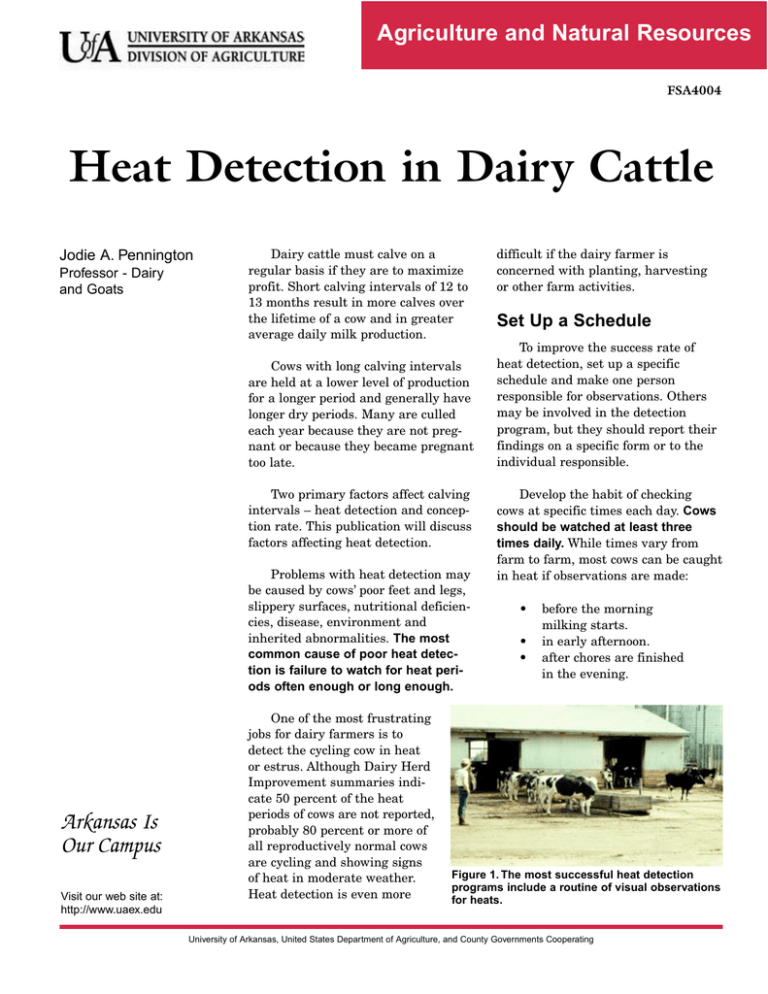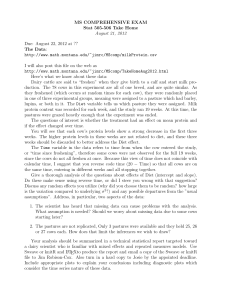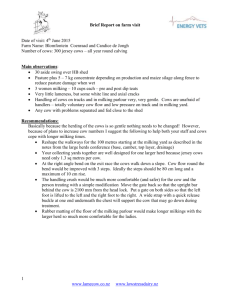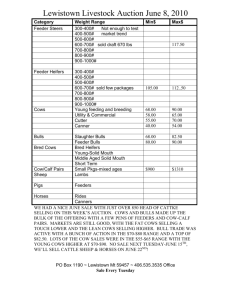Document 11647784
advertisement

Agriculture and Natural Resources FSA4004 Heat Detection in Dairy Cattle Jodie A. Pennington Professor - Dairy and Goats Dairy cattle must calve on a regular basis if they are to maximize profit. Short calving intervals of 12 to 13 months result in more calves over the lifetime of a cow and in greater average daily milk production. Cows with long calving intervals are held at a lower level of production for a longer period and generally have longer dry periods. Many are culled each year because they are not preg­ nant or because they became pregnant too late. Two primary factors affect calving intervals – heat detection and concep­ tion rate. This publication will discuss factors affecting heat detection. Problems with heat detection may be caused by cows’ poor feet and legs, slippery surfaces, nutritional deficien­ cies, disease, environment and inherited abnormalities. The most common cause of poor heat detection is failure to watch for heat periods often enough or long enough. Arkansas Is Our Campus Visit our web site at: http://www.uaex.edu One of the most frustrating jobs for dairy farmers is to detect the cycling cow in heat or estrus. Although Dairy Herd Improvement summaries indi­ cate 50 percent of the heat periods of cows are not reported, probably 80 percent or more of all reproductively normal cows are cycling and showing signs of heat in moderate weather. Heat detection is even more difficult if the dairy farmer is concerned with planting, harvesting or other farm activities. Set Up a Schedule To improve the success rate of heat detection, set up a specific schedule and make one person responsible for observations. Others may be involved in the detection program, but they should report their findings on a specific form or to the individual responsible. Develop the habit of checking cows at specific times each day. Cows should be watched at least three times daily. While times vary from farm to farm, most cows can be caught in heat if observations are made: • before the morning milking starts. • in early afternoon. • after chores are finished in the evening. Figure 1. The most successful heat detection programs include a routine of visual observations for heats. University of Arkansas, United States Department of Agriculture, and County Governments Cooperating Table 1. Efficiency of Heat Detection Observed Period Number of times observed for heat 10 minutes 20 minutes 30 minutes 60 minutes 1X daily 22% 31% 36% 39% 2X daily 33% 43% 55% 61% 3X daily 45% 55% 65% 71% 4X daily 49% 61% 71% 78% If only two observations can be made daily, watch cows before morning activity starts and after evening chores are finished. Another possibility is to watch at sunrise and sunset if that schedule is more feasible. It is also important to observe for heat in an area where cows have the best footing to prevent slipping when riding. Most mounting will probably occur where dirt is available to the cows. Each detection period should last at least 20 to 30 minutes (Table 1). There will be a substantial variation in the amount of time between mounts for each individual animal. Some cows will be very active with several mounts in 15 to 20 minutes, while other cows will receive only one mount during this time period. Cows that are not very active may have more than 20 to 30 minutes between mounts. Remember that cows show more signs of heat when other activity is minimal – not at milking or feeding time (Table 2 and Figure 2). Because of this, the best time to watch for signs of heat will vary from farm to farm. The different periods of Figure 2. Effects of milking on mounting activity. observation should be spaced as far apart as possible, since some cows will be in heat for six to eight hours In one study, we recorded the location of mounts or less. and other sexual activities for cows in moderate weather in a drylot environment. Over 89 percent of the mounts and 86 percent of the sexual activity The time of day that cows show signs of heat occurred in the drylot and the feeding area. Only a may shift due to environmental extremes. In cold small amount of activity took place in the alley of the weather, more mounting may occur during the warm barn and the holding pen. And practically none parts of the day, while the opposite is true in hot occurred in the stalls, the lane to the parlor or the summer weather (see Figure 2). milking parlor. Table 2. Effect of Management Practices Mounts Total Sexual Activities Number/hour Number/hour 1/2 hour postfeeding 2.4 54.0 2 hours at milking time 1.9 24.9 Time other than feeding and milking 6.4 71.4 Time Know Which Cows to Watch Maintain records so the reproductive status of each cow is known. In larger herds, color code animals to indicate their reproductive status. Use neck tags, neck chains, leg bands and/or chalk. For example, a cow to be bred may have a red neck tag, while a cow that has been bred but not confirmed pregnant may have a green neck tag. For herds with more than one group, cows to be bred should be in one group. Make a heat expectancy list of open cows or cows that have been bred but not confirmed pregnant. Watch these cows closely, especially the ones that are 18 to 24 days from their last heat period and those fresh for at least 35 days. Know What to Watch For Learn how cows in heat behave. In general, a cow that stands firmly when ridden is in heat, unless there is some reason to suspect otherwise. Aside from standing, cows in heat may behave quite differently. Some cows are aggressive in both mounting and receiving mounts and stand for a day, while other cows stand to be ridden for only one to two hours. A small percentage of cows may not stand at all. In observing your cows, it is important to watch carefully since a typical mount may last only 5 to 10 seconds. A ruffled tailhead, mud on the back or sides, a swollen vulva or a clear mucous discharge in the vulva region may indicate a cow in heat. Behavioral Figure 3. A combination of heat detection aids can improve accuracy. Above, the cow has a Kamar® mount detector plus chalk on the tail bone. changes, such as nervousness, being off feed and seeking another cow’s company, are further indica­ tions that an animal may be in heat or near heat. While these other signs can confirm heat detection, they can lead to errors in detection if not accompanied by the best sign – the cow standing firmly to be ridden. Use Heat Detection Aids If, after trying the above suggestions, heat detection is not satisfactory, consider using a heat detection aid. Combinations of heat detection aids also may improve accuracy of detection (Figure 3). The more commonly used heat detection aids include: (1) Marking crayons which are used on the rump of the cow and then smeared if the cow is ridden (Figure 4). (2) Pressure-sensitive pads which glue to the rump of the cow and (a) emit a red liquid when the pad is mounted or trigger a computer-linked response to indicate the cow has been ridden (Figures 4 and 5), (b) are erased to show red (Figure 6) or (c) are computer-linked modules that can record the time and/or number of mounts that a cow receives (Figure 7). (3) Chin-ball markers which are used on bulls with penis amputated or deflected and cows or steers treated with testosterone (Figure 8). Figure 4. Chalk or other marking devices can be used with other heat detection aids, such as the Kamar® heat patch. Figure 5. Kamar® heat patches turn red when pressed. Figure 7. HeatWatch® can indicate when a cow is first mounted and the number of mounts received. Figure 6. Estrus Alert® is one type of heat detection aid. These methods allow the animals in heat to be marked, and then AI is used to breed them. However, the chin-ball marker is not normally used unless the first two methods have not produced satisfactory heat detection. Other methods such as combinations of aids, milk progesterone, video recorders, pedometers and vaginal probes may assist in detecting heat in a few herds. Remember that these detection aids require both time and other supplies, including some­ times very expensive computer-related items. Addi­ tional time in watching for heat is recommended. Although altered heat detection aids may indicate the cow has been ridden, changes do not necessarily mean that she has been in heat. The aids may be altered by other means, such as another cow attempt­ ing to ride her or the cow may activate the detector by rubbing on a tree or other item. Figure 8. Chin-ball markers may be used with hormonetreated cow, steer or bull treated with an amputated or deflected penis so he cannot breed the cow. When a single heat detection aid is activated, use other signs of heat to confirm that, indeed, a cow is in heat. We have used a combination of heat mount detectors and chalk with much success in reducing errors in detection (Table 3). However, both aids require daily maintenance in order to be successful. Although the mount detectors plus chalk improved reproductive performance over other treat­ ments, more time is required for applying and main­ taining two heat detection aids. Also, additional money is required to purchase two aids. Combinations of heat detection aids may be beneficial in decreasing the number of false positives. Although more effort is required, combinations of aids may benefit dairymen having problems detecting cows in heat. They may also solve problems with conception rates of cows detected incorrectly and bred at inappropriate times. Table 3. Accuracy and Efficiency of Heat Detection During Continuous Observations for Cows With More Than One Mount Methods of Identifying Heat Items Three 30-minute observations per 24 hours Mount detector Chalk Mount detectors plus chalk 60.6 93.9 93.9 93.9 0 28 38 3 100 52.5 44.9 91.7 Percent efficiency of cows detected in estrus False positives Percent accuracy of detection Choice of heat detection aids may depend on the dairy farmer’s willingness to allocate time for daily upkeep. Chalk requires at least daily maintenance in humid weather. It stays on the cow better in drier climates. All aids will yield more reliable data with routine daily maintenance. Other heat detection aids include pedometers (measure the activity of the cow, which increases at the time of heat); vaginal probes (measure chemical changes in the vagina as the cow approaches the time of breeding); and use of a “gomer” bull, normally with a chin ball marker. Since “gomer” bulls are surgically or nonsurgically altered so they cannot breed a cow naturally, they may lose their sex drive or libido after being with the cows. These aids may be used with much success under good management. Heat Synchronization Various hormonal treatments for heifers and cows are now available to aid in getting animals bred. Some schemes for synchronization require heat detection before breeding, and other schemes allow breeding without heat detection. These methods of heat synchronization require additional costs for purchase of hormones and additional handling of the cattle. However, they may increase the pregnancy rate in the herd. Information concerning heat synchronization methods are in other fact sheets. Figure 9. Proper breeding techniques are needed to complement heat detection in getting cows pregnant. Summary Heat detection can be a very frustrating and costly problem. In setting up schedules for heat detection, observe cows when other activities are minimal. Be more concerned with disruptions in the routine by practices such as feeding and milking than the occurrence of heat during nighttime hours. Know which cows to expect in heat. Group cows to be bred, if possible. If heat detection is not satis­ factory, heat detection aids may be of benefit. How­ ever, the best reproductive management program includes frequent observations for mounting and, when necessary, aids and scheduled observations for cows that are difficult to catch. Printed by University of Arkansas Cooperative Extension Service Printing Services. DR. JODIE A. PENNINGTON is professor - dairy and goats, University of Arkansas Division of Agriculture, Little Rock. FSA4004-PD-7-09RV Issued in furtherance of Cooperative Extension work, Acts of May 8 and June 30, 1914, in cooperation with the U.S. Department of Agriculture, Director, Cooperative Extension Service, University of Arkansas. The Arkansas Cooperative Extension Service offers its programs to all eligi­ ble persons regardless of race, color, national origin, religion, gender, age, disability, marital or veteran status, or any other legally protected status, and is an Affirmative Action/Equal Opportunity Employer.






